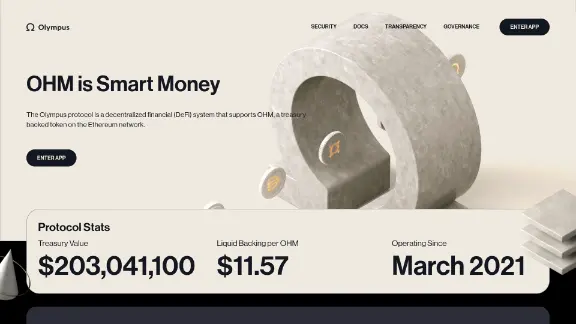Olympus (OHM)
OHM is an ERC-20 token built on the Ethereum blockchain, serving as the foundational element of the Olympus DAO. This decentralized reserve currency protocol introduces OHM as a "flatcoin," which is not linked to any fiat currency. Instead, it uses the Range Bound Stability (RBS) system to ensure a stable and transparent price range. The protocol rewards OHM stakers with compounding interest, thereby increasing their holdings over time.
Olympus DAO launched OHM as a novel alternative to both cryptocurrencies and stablecoins. Unlike stablecoins, OHM's value is not pegged to another currency but is backed by DAI in the treasury. The goal is to balance the stability of fiat-pegged stablecoins and the volatility of cryptocurrencies, offering scalability through an on-chain mechanism. The project, founded by a pseudonymous individual known as Zeus, emphasizes community involvement and has undergone significant updates, including the migration to Olympus V2, which enhances governance and expands its reach across multiple blockchain networks.
Launched in March 2021, OHM debuted via a Discord offering and an Initial Decentralized Exchange (DEX) Offering (IDO), where early adopters could purchase OHM tokens. The project attracted investment from notable venture capital firms such as D64 Ventures and Zee Prime Capital, which also invest in projects like Solana and Polkadot.

| Ticker | OHM |
| Category | Crypto-Backed Tokens |
| Website | https://olympusdao.finance/ |
| @OlympusDAO | |
| Telegram | OlympusTG |
| https://www.reddit.com/r/olympusdao/ | |
| Contract Addresses | |
|---|---|
| ethereum | 0x64...d5 Copied! Copied! |
| arbitrum-one | 0xf0...28 Copied! Copied! |
| base | 0x06...c0 Copied! Copied! |
V2 migration
The transition to OHM V2 brought several improvements, including on-chain governance and auto-staking for bonds, enhancing user experience and flexibility. The migration process involves converting sOHM V1 to gOHM, allowing users to acquire multiple bonds during a single vesting period.
Partial liquidity for OHM V1 remains accessible during the migration, ensuring users can manage their positions effectively. The migration replaces wsOHM V1 (wrapped, staked OHM) with gOHM (Governance OHM), supporting on-chain governance. Despite differences in gOHM balances due to its pricing structure, the value remains consistent.
OHM and sOHM tokens receive V2 counterparts, with OHM V1 becoming OHM V2 and sOHM V1 transitioning to sOHM V2. Post-migration, V2 tokens are necessary for new bonds, liquidity pools, and integrations like Abracadabra.
gOHM token
gOHM (Governance OHM) is an ERC-20 token used for governance within the Olympus protocol. It enables users to propose upgrades and participate in decision-making processes. gOHM can be acquired by wrapping OHM and serves applications such as governance voting and collateral for obtaining Cooler Loans.
Technology
OHM is backed by Dai tokens in a 1:1 ratio, with each OHM token having a corresponding DAI token in the treasury. The protocol manages supply by buying back and burning OHM when trading below 1 DAI and minting and selling OHM when trading above 1 DAI, ensuring profitability and backing by real assets.
OHM tokens are created and distributed as staking rewards. More OHM staked reduces the annual percentage yield (APY) but helps maintain a balanced system that supports user investments.
Features
OHM staking
Staking is the main strategy for value accrual in Olympus DAO. Stakers earn rebase rewards by staking their OHM, which come from bond sales proceeds. The rewards vary depending on the number of OHM staked and the reward rate set by monetary policy. Staking is facilitated through sOHM, a token representing staked OHM, allowing automatic compounding returns.
OHM bonding
Bonding is a secondary strategy for value accrual, enabling Olympus DAO to acquire liquidity and reserve assets like LUSD. Through bonding, OHM is sold at a discount in exchange for these assets. The bonder receives terms such as bond price and vesting period, with rewards claimable over time.
Hypernative partnership
In March 2024, Olympus DAO renewed its partnership with Hypernative to bolster security through real-time monitoring and threat prevention. This collaboration includes comprehensive monitoring, security advisory services, and custom monitoring capabilities, enhancing the protocol's defenses.
Olympus DAO manages a vast decentralized finance ecosystem with over 120,000 token holders and a significant treasury and market capitalization. By leveraging Hypernative's platform, Olympus aims to safeguard its OHM token and assets.
2022 security event
In October 2022, OlympusDAO experienced a security event involving the BondFixedExpiryTeller smart contract, where approximately 30,000 OHM tokens were withdrawn. The contract, developed by Bond Protocol, was not native to OlympusDAO's ecosystem. The team quickly reassured the community, and the attacker returned the funds to the DAO wallet shortly after.
